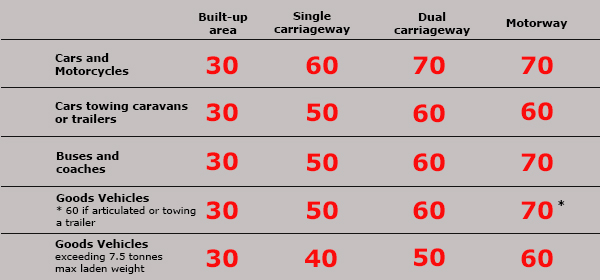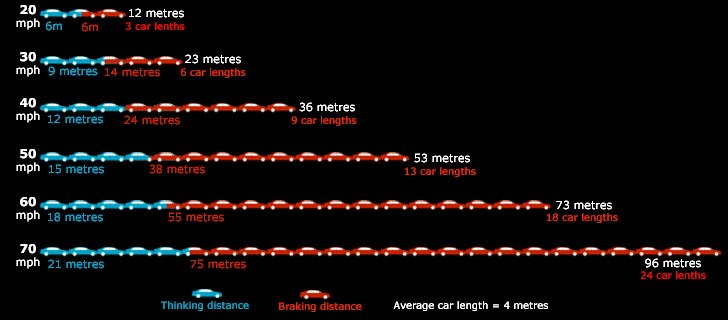Speed Limits & Stopping Distances
You should always keep your speed below the maximum speed limit for the road you are driving on. Although you are not legally obliged to drive at the maximum speed limit, if it is safe to do, you should try and drive at a speed that at least approaches it. For instance, in a 40mph zone, your speed should be between 35 and 40mph.
Driving too slowly can be as dangerous as driving too fast. The driver who toddles along a 60mph road at 40mph causes tailbacks and frustration. This can lead to dangerous overtaking manoeuvres and other road safety issues.
Speed in itself is not that dangerous, but inappropriate speed is. Always take into account the weather and road conditions. Driving at 60mph, even though you are legally entitled to do so when there is ice on the road is dangerous and inappropriate, as is driving at 40mph on a dual carriageway when the weather is fine.
The general speed limit rules for cars are:
- For built-up urban roads with street lighting, the speed limit is 30 mph.
- For single carriageway roads, the national speed limit is 60mph.
- For dual carriageways and motorways, the speed limit is 70mph.
These speed limits apply at all times, whether during the rush hour or the dead of night and are overridden only if a road sign indicates a different speed limit, for instance, it is not uncommon to have a speed limit of 40mph on a road that has street lighting.
Minimum Speed Limits
You won’t often encounter a minimum speed limit however they are sometimes put in place where it is important to keep traffic moving smoothly.
The table below shows the national speed limits for different vehicles on different types of road.

Stopping Distances
The distance, over which you can bring a car to a stop, the stopping distance, depends on four factors.
- The speed at which you are traveling
- The thinking distance – the time it takes you to think about stopping and hit the brakes
- The braking distance – the time it takes for the car to come to a stop after you have applied the brakes. As a general rule, on a good dry road, you can work out the braking distance by using this formula. Take your speed, multiply it by the first digit then divide it by two. The answer is the braking distance in feet. For example, you are driving at 70mph, so 70 x 7 equals 490, then 490 divided by 2, which equals a braking distance is 245 feet.
- The weather conditions – dry roads mean shorter braking distances, wet and icy mean longer braking distances
The following diagram shows overall stopping distances at a variety of speeds when the road surface is dry. If the road were wet the stopping distance would be twice the distance, on icy roads the stopping distance would be ten times as great.

